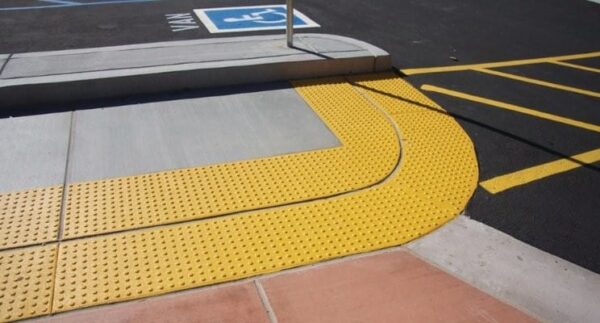Truncated domes are warning surfaces designed and installed in accordance with the Americans with Disabilities Act (ADA) guidelines to ensure the safety and accessibility of public spaces for all individuals. The ADA is a federal law requiring public spaces to be designed and constructed to allow individuals with disabilities to access them. The law covers all areas of public life, including employment, transportation, and access to state and local government services.
This article will take a closer look into the design and installation of a truncated dome. That being said, let’s get started with the reading.
Design of Truncated Domes
Truncated domes are designed to be highly visible and distinguishable to individuals who are visually impaired. The design of truncated domes includes several key elements:
- Dome shape: Truncated domes are typically dome-shaped, with a raised surface that can be easily detected by a cane or underfoot.
- Dome size: The size of the truncated dome is determined by the surface area where it will be installed. The domes must be large enough to be easily detected but not so large that they impede pedestrian traffic.
- Dome spacing: The spacing between truncated domes is also carefully calculated to ensure that they can be easily detected by individuals who are visually impaired. The spacing between domes must be consistent and not too close together to allow for easy detection.
- Color and contrast: Truncated domes are typically yellow or red in color to contrast with the surrounding surface and be highly visible.
Installation of Truncated Domes
Truncated domes can be installed using several different methods, including adhesive, embedded, or surface-mounted. The installation method used will depend on the surface where the truncated domes will be installed and the specific needs of the project.
- Adhesive installation: This method involves applying an adhesive to the surface where the truncated domes will be installed and then pressing the domes into place. This method is typically used for surfaces that are smooth and flat, such as concrete or asphalt.
- Embedded installation: This method involves installing the truncated domes into a wet concrete surface. This method is typically used for surfaces that are being newly constructed or undergoing a major renovation.
- Surface-mounted installation: This method involves installing the truncated domes on top of an existing surface using a mechanical fastening system. This method is typically used for surfaces that are already in place and cannot be removed or modified.
Material Selection
Truncated domes are typically made of durable materials such as rubber, plastic, and concrete. The material selected for a project will depend on the specific needs of the project and the environment where the truncated domes will be installed.
- Rubber: Rubber truncated domes are flexible and durable, making them a good choice for outdoor installations. They are also relatively inexpensive and easy to install.
- Plastic: Plastic truncated domes are also durable and flexible, and they are a good choice for indoor installations. They are also relatively inexpensive and easy to install.
- Concrete: Concrete truncated domes are the most durable of all materials, making them a good choice for heavy-traffic areas. They are also relatively expensive and require specialized installation methods.
Maintenance and Replacement
Truncated domes require regular maintenance to ensure that they remain in good condition and continue to provide a safe and accessible environment for visually impaired individuals. Regular maintenance should include cleaning and inspecting the truncated domes for any signs of wear or damage. If any truncated domes are found to be damaged or worn, they should be replaced immediately to ensure the safety of the visually impaired and other individuals too.

